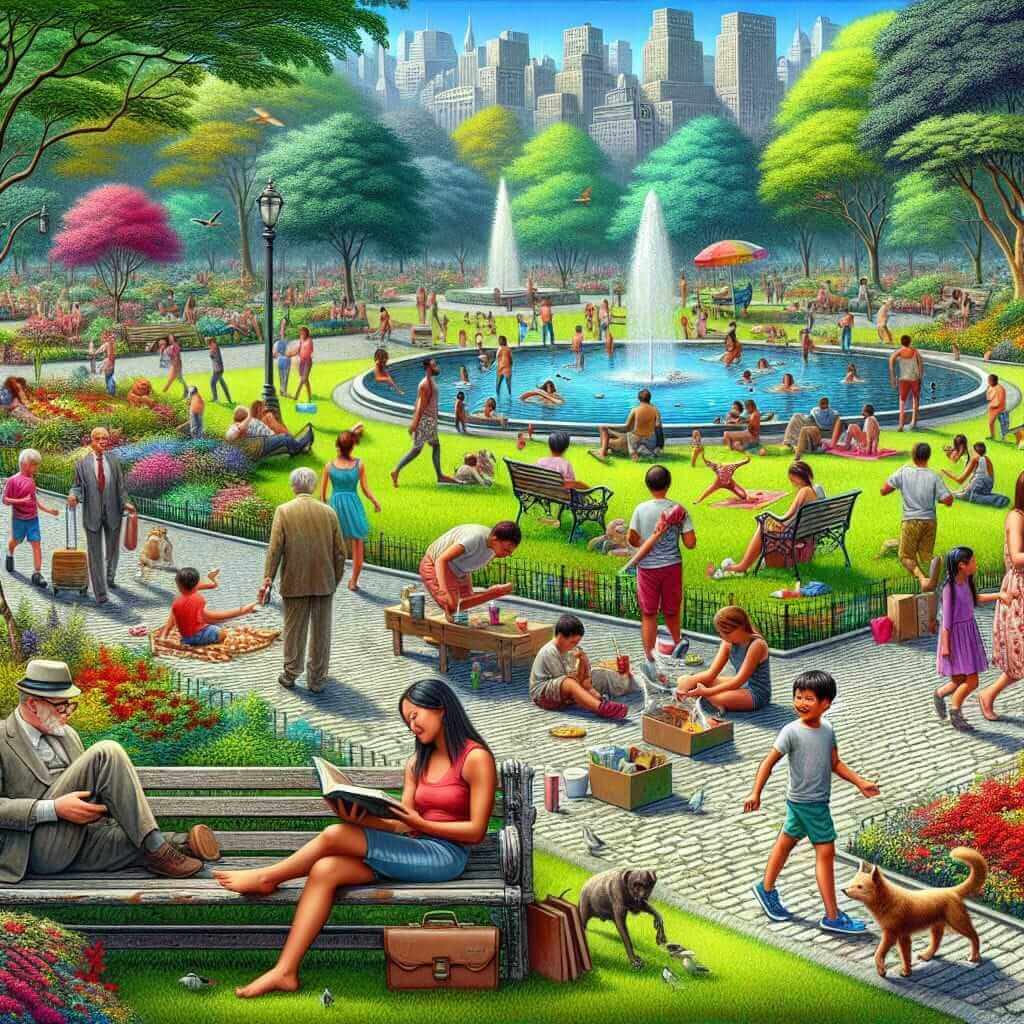The role of public parks in urban areas is a topic frequently discussed in various contexts, including the IELTS exam. This theme delves into the multifaceted benefits of green spaces within concrete landscapes and often explores the social, environmental, and economic implications of maintaining these areas.
This comprehensive guide will provide valuable insights into crafting a high-scoring IELTS Writing Task 2 essay on this subject. We will analyze potential exam questions, dissect a sample essay, and equip you with essential vocabulary and grammatical structures to excel in your IELTS writing endeavors.
Sample IELTS Essay Questions
Here are some potential IELTS Writing Task 2 questions related to “The role of public parks in urban areas”:
- In many cities, green spaces are being replaced by housing and commercial development. Do the advantages of this trend outweigh the disadvantages?
- Some people believe that public parks and gardens are essential for city life. Others, however, argue that they are unnecessary and a waste of valuable space. Discuss both views and give your own opinion.
- With increasing urbanization, it is becoming increasingly important to create more green spaces within cities. What are the benefits of having parks and gardens in urban areas, and how can they be effectively incorporated into city planning?
Sample Essay Analysis: Question 1
Let’s choose the first question for our sample essay: In many cities, green spaces are being replaced by housing and commercial development. Do the advantages of this trend outweigh the disadvantages?
Analysis of the Question:
This question requires you to present a balanced argument, discussing both the merits and drawbacks of replacing green areas with urban development. You must then provide a clear opinion on whether the benefits outweigh the downsides.
Sample Essay:
In a world grappling with rapid urbanization, the conflict between maintaining green spaces and accommodating growing populations has become increasingly pronounced. While replacing parks and gardens with housing and commercial infrastructure might offer certain advantages, I firmly believe that the disadvantages of this trend significantly outweigh the benefits.
On the one hand, converting green spaces into residential and commercial zones can contribute to economic growth and address housing shortages. By creating more homes and businesses, cities can attract investments, create jobs, and generate higher tax revenues. Furthermore, denser urban development can lead to more efficient use of resources and infrastructure, potentially reducing commute times and energy consumption.
However, the environmental and social costs associated with sacrificing green spaces are undeniable. Parks and gardens play a crucial role in mitigating air pollution, reducing the urban heat island effect, and providing habitats for wildlife. Their disappearance not only exacerbates environmental degradation but also deprives city dwellers of essential recreational areas that promote physical and mental well-being. Studies have shown that access to green spaces can reduce stress, improve cognitive function, and foster social cohesion within communities.

Moreover, the cultural and historical significance of many parks cannot be overlooked. These spaces often serve as landmarks, hosting community events and preserving the city’s heritage. Replacing them solely for economic gain undermines the character and livability of urban environments.
In conclusion, while the economic benefits of replacing green spaces with development might seem appealing in the short term, the long-term environmental, social, and cultural implications are far too detrimental to ignore. It is imperative for city planners and policymakers to prioritize the preservation and expansion of green spaces to ensure the well-being of both current and future generations. (Word Count: 298 words)
Writing Tips:
- Structure: Follow a clear and logical essay structure: Introduction, Body Paragraph 1 (Advantages), Body Paragraph 2 (Disadvantages), Conclusion.
- Balanced Argument: Present a well-rounded discussion, acknowledging both sides of the issue before presenting your opinion.
- Supporting Evidence: Provide relevant examples, statistics, or studies to strengthen your arguments.
- Vocabulary: Use a wide range of vocabulary related to urban development, environment, and social issues.
- Grammar and Cohesion: Ensure grammatical accuracy and use cohesive devices (linking words, pronouns) for a smooth flow of ideas.
Vocabulary Highlights:
- Urbanization (noun) /ˌɜːrbənɪˈzeɪʃən/: The process of making an area more urban.
- Infrastructure (noun) /ˈɪnfrəstrʌktʃər/: The basic physical and organizational structures and facilities (e.g., buildings, roads, power supplies) needed for the operation of a society or enterprise.
- Mitigate (verb) /ˈmɪtɪɡeɪt/: Make (something bad) less severe, serious, or painful.
- Urban heat island effect (noun): A phenomenon where urban areas experience higher temperatures than surrounding rural areas due to human activities and surfaces.
- Cohesion (noun) /koʊˈhiːʒən/: The action or fact of forming a united whole.
Conclusion
Mastering the art of writing about “The role of public parks in urban areas” in the IELTS exam involves understanding the nuances of the topic, crafting a well-structured argument, and utilizing a rich vocabulary. This guide provides a solid foundation for approaching this theme. Remember to practice regularly, analyze sample essays, and familiarize yourself with relevant vocabulary to enhance your writing skills and achieve your desired IELTS band score. For further practice, consider exploring topics related to “urban green spaces,” “sustainable city planning,” or “the impact of urbanization on the environment” to broaden your understanding and vocabulary.